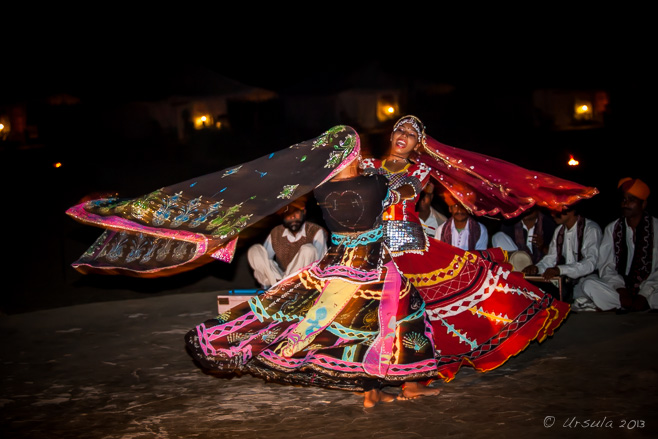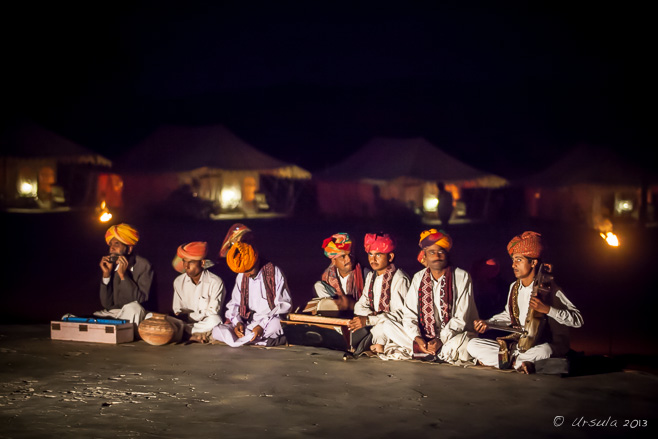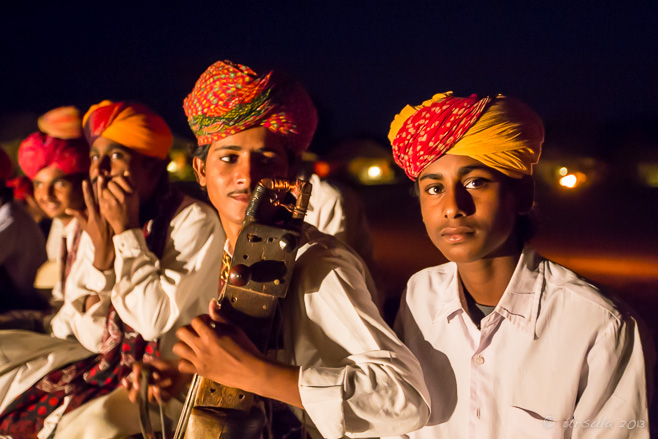
Rajasthani Gypsy Dancers
Flickering light from a small fire in the temperate desert night, the haunting sounds of Indian woodwinds and syncopated drums, swirling dresses and rising song: it is a gypsy performance under the stars – guaranteed to make you smile.
Cool sands underfoot. Starry, wide-open skies overhead. Firelight and music and drums.
There is magic in the desert air.
“Midnight at the oasis
Send your camel to bed
Shadows paintin’ our faces
Traces of romance in our heads…”
– Midnight at the Oasis by David Nichtern for Maria Muldaur
It was nighttime in the middle of the Thar Desert.
The Great Indian Thar Desert in northwestern India forms an expansive boundary with Pakistan. Also called the Marusthali, or “Land of the Dead” in Sanskrit, the region is none-the-less rich with its own unique life. My travel companions and I, with photographer Karl Grobl and local guide DV, had spent a fascinating day visiting with villagers in the heart of the arid, rolling dunes (see: Everyday Life in the Great Thar Desert), and were now reclined on chairs set deep into the sand.
Camels snorted in the shadows. The soft lamp-light from the tents in the background didn’t reach the low tables in front of us as we snacked on spicy nibbles we could barely see. Seated cross-legged on a concrete “performance space”, Rajasthani Kalbelia or Kabeliya men entertained us with the traditional music of the nomadic desert tribes: music played on the morchang, or jaw-harp; the sarangi, the most important stringed instrument in north-Indian folk music; the dufli or daf, a goat-skin tambourine; and various percussion instruments, including the dholak, or two-headed drum.

Rajasthani Gypsy Musicians
Seated on the concrete “performance space”, musicians entertain us with plaintive melodies and syncopated beats.

Rajasthani Gypsy Musicians

Family of Kalbelia Dancers
“Back stage”, two Kalbelia gypsy dancers and their young brother pose for pictures.
In the darkness behind the musicians, the evening’s “main attractions” – two Kalbelia gypsy dancers – were getting ready for their performance. With their younger brother and apprentice musician, they paused for photos in the dark, before their entrance onto the stage.
I’ve written about Kalbeliya gypsy women before: they are “skilled dancers once hired to entertain kings and maharajahs, [but] are now reduced to struggling to preserve their culture.” “Untouchables” under the cast system, these proud, tribal desert nomads have had a recent boost from UNESCO, who in 2010 declared Kalbelia folk songs and dances part of its “List of Intangible Cultural Heritage in Need of Urgent Safeguarding”. Performances at places like the luxurious Manvar Desert Camp where we were being entertained, help support these artistic practices.
The songs and dances themselves are part of an oral tradition based on stories taken from folklore and mythology, and handed down through the generations. But neither the dances nor the songs are codified: the Kalbelia have a reputation for composing lyrics spontaneously and for creating improvisations between the dancers and the musicians.

Kalbelia Dancer
The dancer weaves to the rhythm of the music – and the musicians follow her lead.

Gypsy Dancer
In a swirl of skirts, with feet flashing, the dancer twirls…

Kalbelia Sisters
… before being joined “on stage” by her sister …

Kalbelia Sisters
… and spinning together with her. The flowing skirts are known for their intricate embroidery with silver thread and small mirrors.

Fire in the Foreground

Musicians Performing
A male performer, keeping time with his rhythm sticks, sways gracefully as he sings traditional songs of the Bhopas, the another nomadic tribe. His companions accompany him on a matka, an earthenware pot; and a morchang, the plaintive desert mouth-harp.

Gypsy Backbend
Kalbeliyan dancing requires a balance between suppleness and strength. When the women come back, they demonstrate their flexibility. The younger sister performs backbends …

Collecting Money
… picking up money with her teeth.

Gypsy Backbend
The elder sister goes one better …

Pick-up-Rings
… and picks up rings with her eyes.

Portrait of a Dancer

Dancers Spinning
Hands twisting gracefully, skirts flying, the sisters circle and spin…

Dancers Spinning
… until they almost disappear.

Swirling Fabric

Dancer in Abstract

Black Swirl

A Dancer’s Smile
“… You don’t have to answer
There’s no need to speak
I’ll be your belly dancer, prancer
And you can be my sheik.”
 Music and magic in the night.
Music and magic in the night.
Guaranteed to make you smile.
Namaste!
Pictures: 09November2013


























.png)


Thanks for sharing. Brings back some fun memories.
Thanks for the visit, Michael. Happy Holidays!
colourful show, very nice Ursula. Greetings and I wish you a very happy Christmas and a healthy 2015.
Merry Christmas, Deitmut!
[…] crackles with heat and hope, where life is hard (Life in the Thar Desert) and the nights are magic (Music and Magic). A place where, in the late afternoon, watching some men and their camels on the crest of a sandy […]
[…] We headed back to our camp for a dinner and entertainment under the stars: the nights are filled with traditional gypsy folk music and dance (Celebrating Music and Motion). […]